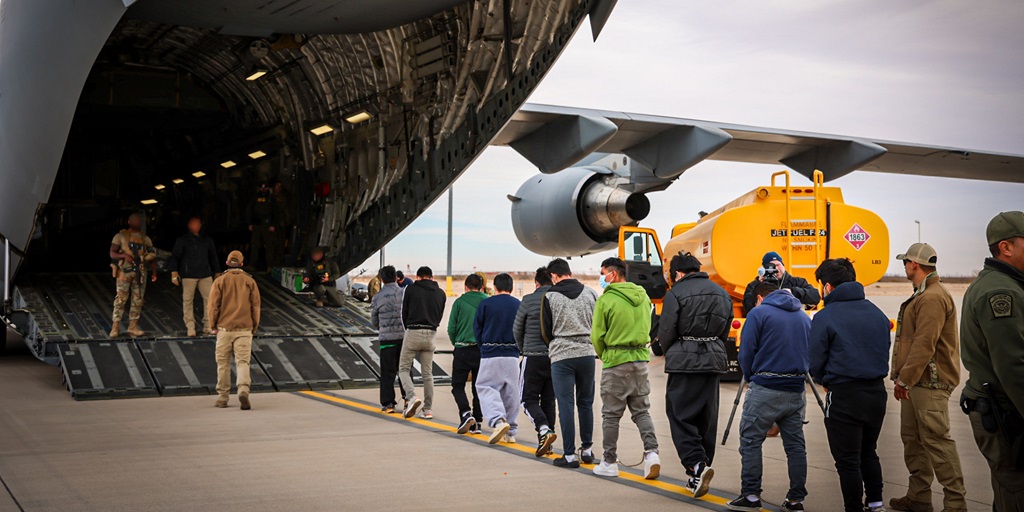Last week, President Trump ordered the Secretary of Homeland Security to expand immigration detention at Naval Station Guantánamo Bay, Cuba to house up to 30,000 people. Since then, U.S. Immigration and Customs Enforcement (ICE) has transferred at least two flights of migrants from the United States to its detention facility there.
Immigration detention at Guantánamo Bay is not new. But this is the first time the United States is using Guantánamo Bay to hold thousands of immigrants already present within its borders. By doing so, President Trump is launching a new era in scale and scope that promises expanded violations of noncitizens’ rights.
Historic Immigration Detention at Guantánamo Bay
U.S. presidents have detained immigrants at Guantánamo Bay for most of the past half century. In the 1970s, Presidents Ford and Carter held dozens of Haitians awaiting asylum interviews on the base. Rough waters rendered the Haitians’ ships unseaworthy and prompted them to seek assistance from the base rather than continue their journey to Florida.
In the 1980s, immigration detention onsite largely ceased. President Reagan ordered the U.S. Coast Guard to interdict Haitians and other migrants at sea to prevent their entry to the United States. He then shifted their asylum proceedings to the decks of Coast Guard cutters.
Detention resumed in 1991. A violent military coup in Haiti prompted an exodus that overwhelmed the Coast Guard’s capacity to detain Haitians while their asylum claims were pending. So, President Bush transferred approximately 12,500 Haitians, including women and children, from Coast Guard vessels to a squalid tent camp at the station. President Clinton emptied this camp over the next few years by stripping interdicted Haitians of their right to asylum and expelling them back to Haiti. Clinton later reopened the camp in 1994 to house tens of thousands of Cubans and Haitians without adequate food, water, and sanitation.
Contemporary Immigration Detention at Guantánamo Bay
Prior to Trump’s declaration last week, the Migrant Operations Center (MOC)—ICE’s detention facility at Naval Station Guantánamo Bay—housed only Cuban and Haitian migrants interdicted at sea before entering the United States. Little information is publicly available about detention in the 120-bed MOC, though reporting indicates it averaged a population of 20 migrants per day in 2022.
Under the interdiction scheme in place since the early 1990s, the U.S. government no longer considers migrants interdicted at sea for asylum. It does, however, resettle those with sufficient fears of return to their home countries to third countries like Canada.
To facilitate resettlement, the Coast Guard transfers interdicted migrants into ICE custody at Guantánamo Bay if they express fears of return to both the Coast Guard and a U.S. Citizenship and Immigration Services (USCIS) official. At Guantánamo, USCIS reassesses these migrants’ fears of return. ICE repatriates those who fail this reassessment and transfers those who pass to State Department custody elsewhere on the naval base for resettlement abroad.
Trump’s Planned Use of Guantánamo Bay
Detaining as many as 30,000 noncitizens in Guantánamo Bay is a costly—and abusive—shift in immigration detention. It imposes a unique expense and threat to immigrants’ rights without any advantage for the U.S. government other than the harm it poses to noncitizens. This time, though, that harm can be addressed in court.
Expanded immigration detention at Guantánamo Bay will likely be quintuple the average immigration detention bed cost of $57,378 annually. As of August 2024, ICE pays a private prison company about $32.68 million a year to provide 120 detention beds at the MOC. That comes out to $272,409 per bed. The detention facility run by the Department of Defense at Guantánamo Bay costs more, some $13.5 million per bed each year.
Traditionally, Guantánamo Bay offers the United States unique appeal for holding immigrants who have not yet reached the United States. It allows the government to detain such immigrants without them accruing statutory and constitutional rights from presence in U.S. territory. But for immigrants in the United States who have a right to seek asylum and make a case before an immigration judge under U.S. law, Guantánamo Bay is just an abuse-ridden detention facility on an impossible-to-access military base abroad. The logistics of ensuring people transferred from the United States to Guantánamo retain access to their lawful due process rights and receive humane treatment will be enormous—which is likely a feature, not a bug.
Expanded detention in Guantánamo forbodes human rights violations. But the Trump administration will face lawsuits for those violations. Unlike the noncitizens detained in Guantánamo by past administrations, those being transferred there now have rights under U.S. law.
FILED UNDER: Cuba, Trump administration


